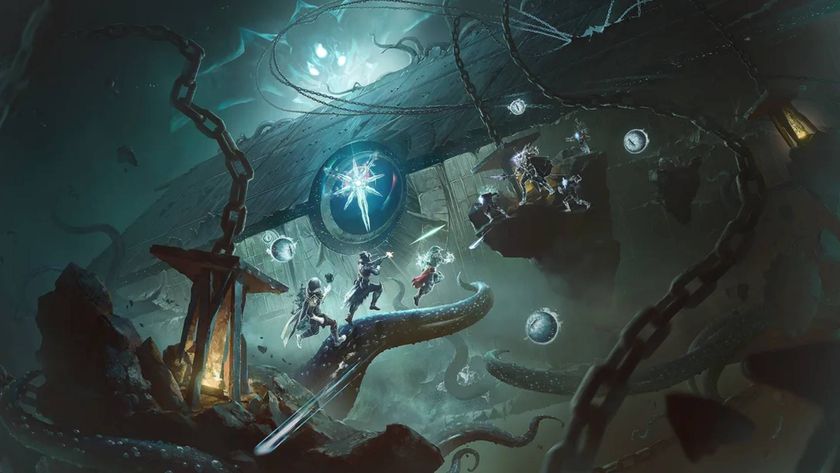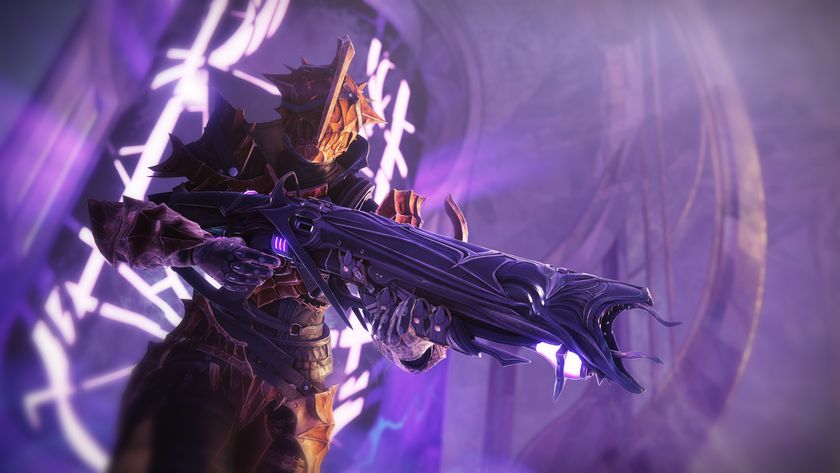Destiny 2 on PC is no mere port. 8 hours' hands-on reveals perhaps the purest, most definitive version of the game
Looking and playing better than ever before, Bungie's bespoke PC version of Destiny 2 frees a fantastic game to realise even greater potential

“There was a goal to have us not talk about it as a port”, says David Shaw, Bungie’s PC lead for Destiny 2. “It’s not a port. It’s a ground-up re-envisioning of what this game should be on PC, and that was always what it was about, and we weren’t going to do it any other way”.
It should be easy to brush such statements off as PR bluster, of course. PC gamers have often had to await incoming, latecoming versions of big, console productions with gritted teeth and clenched knuckles, bracing for the potential impact of lazy ports, poor optimisation, DRM hell, and any manner of other, detrimental factors speaking to a second-class treatment of the most powerful and versatile format around. But this time it’s different. Because by the time I hear Shaw’s words, I’ve already spent a full day with the PC version of Destiny 2, and its developers do not need to convince me. Rather, they’re confirming what I already know to be true.
- Destiny 2 guide: complete campaign walkthrough and guides for how to save the Traveler
- Essential Destiny 2 tips: The things we wish we knew before we started playing
The PC version of Destiny 2 is not a simple port. It’s not even just a good port. The entire fabric of the game – both technically and experientially – screams of a dedicated, bespoke build of the game, crafted with real attention and care for making not just ‘Destiny 2 on PC’, but Destiny 2 as built for PC. It screams all of that like a battle-cry.
In hindsight, it perhaps shouldn’t be surprising, although given the scarcity of Bungie games in the realm of keyboard and mouse – there hasn’t been one since Halo 2 in 2007 – low expectations could be justified. But Destiny has always been a series built with scalability and bespoke requirements in mind. The first game saw Bungie jump from single platform development to covering Xboxes and PlayStations straddling two different console generations simultaneously. Things took an immediate and noticeable technical step-up when the Rise of Iron expansion launched for current-gen machines only in 2016, and Destiny 2 on console marks another resounding leap forward. In that context, the gains made by the PC version are the next logical step. But it’s still impossible not to be impressed.
Breaking through the level cap

On a purely visual level, this is an uncompromised (and uncompromising) evolution beyond the already beautiful console version, made all the more impressive by its surprise nature. Given the first game’s absence from the PC, it would have been easy to assume a lack of passion for the format at Bungie, but Shaw tells me that’s far from the case, explaining that the platform’s importance was actually the reason it didn’t get a version of the first Destiny.
“We didn’t believe we could do it properly. We had four platforms. We’d gone from shipping our old titles, which were one platform, ever, to shipping on four simultaneously, so Destiny One was a big change for us. We were developing the processes that we needed to get where we are, and Destiny 2 was an opportunity to say “Hey, you know what? We’ve got an opportunity to do this and we believe we can do it right.
“It wasn’t whether Destiny was or should or couldn’t be a PC game, it’s that if we were going to bring it to PC, we weren’t going to do it in a limited [way].
Sign up to the 12DOVE Newsletter
Weekly digests, tales from the communities you love, and more
“People say ‘Well, why didn’t you give us this two or three years ago?’ Well, we couldn’t give you this two or three years ago, that’s why. Not even close.”

- How to level up fast in Destiny 2
- Destiny 2: How to get to Power level 280 (and beyond) while playing solo
So with Destiny 2’s current-gen only launch freeing up Bungie’s internal bandwidth to take on a PC version, a partner studio was found in Vicarious Visions (an arrangement that both Shaw and VV lead engineer Thomas Gawrys are keen to emphasise was not an outsourcing process; staff at both studios formed one collective team, “on five calls a day sometimes”), and work began.
Or rather, it continued. Because, despite what you might assume, given Destiny 2’s one-month delayed release on the PC, this version wasn’t a late addition to the schedule any more than it was a port. Bungie might not have had the freedom to release a PC version of Destiny in 2014, but it did have the technical ability, as Shaw clarifies.
“Technically the PC project started years ago because a lot of our technology... we tend to think far ahead. To give an example, our artwork has been HDR capable for years, it’s just HDR didn’t exist yet in a format that was available to consumers. All of our stuff has been generated that way, so when it came along, we were just like ‘Oh we’ll just need to go and...’”
Gawrys elaborates. "We use our PCs to develop, and we’re using that in all things, so it’s existed in a sort of very naive, not-shippable form for a long time. So there’s been a lot of scalability in development”.
“And we know that there’s going to be future consoles and that there’ll be future developments in PC hardware”, continues Shaw, “and so if you’re going in adding a feature, sure you might only need it to do X today, but you probably want to make sure you’re thinking about how to easily go far beyond what’s there all the time. So a lot of what we did, the seeds were planted years ago and so we just took advantage of those things”.

Advantage indeed. Because while the boons gained by Destiny 2’s latest upgrade would be handsome in any game, they feel particularly beneficial to Bungie’s first PC game in 14 years. Simply, Destiny 2 just feels right on the PC. I did worry at first, whether Bungie’s distinctive FPS combat model - honed over almost two decades, and specifically for console controllers - would translate. Would the pace and rhythm, that natural ebb and flow of Bungie’s almost musical combat, prevail in a world of instant 180 spins and pinpoint accuracy? But it does. After acclimatising to the new muscle memory required, one thought very quickly becomes very loud in my head. “Holy crap, I’m playing Destiny”.
But it isn’t just Destiny. Destiny on PC is a cleaner, more refined, more immediate version of the game. Far from being an easy mode – the imagined game-breaking speed and accuracy of keyboard and mouse is tempered surprisingly well by the removal of Bungie’s invisible but potent aim-assist – this is simply Destiny’s consummately kinetic, improvisational, omnidirectional gunplay freed from the barriers and limitations of control that were never previously apparent. While it initially feels like a modified special edition, rather quickly, keyboard-and-mouse Destiny begins to feel like Destiny played in its purest state.
A good, clean fight

- Destiny 2 Chest locations guide - find every Region, Lost Sector, and Treasure Cache
- Destiny 2 Scannable Object locations guide - find every bit of hidden lore
Bungie’s combat is rightly famed for being some of the most adaptably expressive around. Really, underneath all the loot drops, levelling, and confounding Raid challenges, that’s the central joy that makes Destiny so endlessly vital, three years after the first game’s release. On the PC, we have the most direct, expressive version of it I’ve ever experienced. Resolute PC gamers previously deprived are in for a hell of a giddy, dynamic treat. Stalwart Halo and Destiny fans thinking of making a move can expect to fall for their favourite FPS all over again, in a brand new way.
Visually, too, the extra fidelity (particularly when running at 60 frames per second, as a Bungie game has never done before; another barrier removed), lends itself especially well to the distinctive design of Destiny’s world. The series’ signature combination of chunky sci-fi weight and ethereal, pseudo-supernatural weirdness has never felt so tangibly heavy, or enjoyed such oddly unsettling grandeur. And as with so much of Destiny 2, a multitude of small details stack up to great effect.
The newly slick, industrial crates on Titan, thick with the driving, oceanic rain that crafts so much of the setting’s atmosphere. The layered textures and finishes to the rust on Vex installations on Nessus, telling a tale of age, dereliction, and ancient, decaying, technological prowess. And everywhere, there’s the simple but powerful way that the option to expand the game’s field of view adds new impact to Destiny 2’s many, now more strikingly lit vistas, across arresting extraterrestrial landscapes and within the vast, arcane otherworlds of its subterranean dungeons.

- Destiny 2 Crucible multiplayer: How each mode works, and how to win
- Destiny 2 - the best weapons and how to get them
And I’d be remiss to round off without mentioning Crucible PvP. Destiny 2’s tighter, more tactical remix of the first game’s fast-flowing, Halo-inspired multiplayer is an even greater delight on PC. While nothing has fundamentally changed in its construction, bar the game’s across-the-board reduction in visual recoil feedback to avoid endless mouse correction, here too Destiny 2 feels purer and more direct.
Without the nominal delays of analogue stick input, the Crucible feels quicker, sharper, and more aggressive, its three-decisions-a-second flow now facilitating five or maybe six. Strategic experimentation and in-the-moment adaptation are even more viable, now that Guardians are so much more mobile and primed to act. It remains to be seen how much this will change the way the Crucible is played, long-term, or whether the weapon meta will be different on PC (though hand cannons do seem to enjoy the extra accuracy), but an exciting new flavour it certainly is.
But that’s Destiny 2 on PC, ultimately. It’s still Destiny 2, with the myriad instant joys and long-terms depths that brings. However, it’s Destiny 2 systematically reworked and amped up, with a marvellous, and categorically zestier, essence.













"A fun example of a bug becoming a feature": Destiny 2 accidentally made Exotic Glaives free to all classes, and Bungie says "we're going to let this ride"

Destiny 2's new Episode suggested the upcoming Apollo expansion will launch on July 15, but that date has mysteriously been scrubbed from the game





